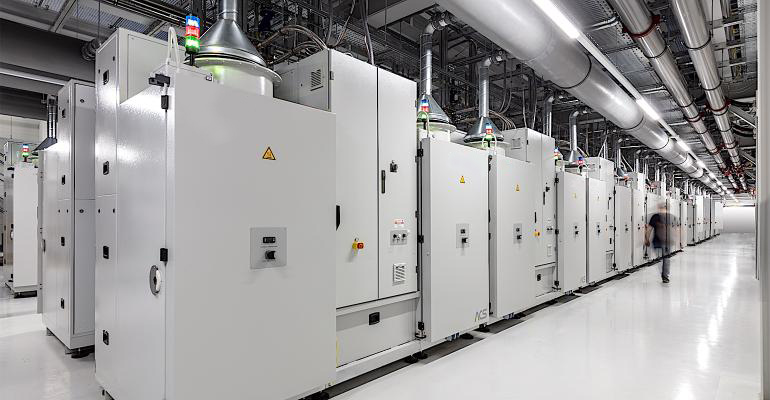This website uses cookies so that we can provide you with the best user experience possible. Cookie information is stored in your browser and performs functions such as recognising you when you return to our website and helping our team to understand which sections of the website you find most interesting and useful. See our privacy policy.
News
Battery Test Lab Design Fundamentals

The proliferation of EV battery cell manufacturing plants and EV battery pack assembly plants is producing a corresponding boom in the construction of battery test labs.
These are needed to verify that battery cells, modules, and completed packs all perform safely and provide the durability customers expect. Considering the need for more of these facilities, Design News has investigated the best practices for designing and building EV battery test labs.
“Everybody is trying to get as many EVs as they can out the door on incredibly short timescales,” observed Elijah Kerry, chief of EV battery test solutions at NI.
Even worse, battery technology is evolving rapidly, which increases the need to test new chemistries extensively. “The market is comfortable with tech selection, locking it down and milking it for the better part of a decade, but batteries are constantly changing,” said Kerry.
In addition to evolving hardware for new cars, cars already on the road use their hardware differently due to changes in their software. “It is compounded by pushing new capabilities through over-the-air updates,” he said.
Physical testing of actual batteries is crucial because digital twins cannot reliably replicate the potential sources of trouble. “To understand how a battery is going to degrade over time, we have to test them,” Kerry stated. “We don’t have the fidelity of models. That’s why we need physical tests. Physical testing might be complemented with simulations.”
Plan to Scale
As more companies add battery testing capabilities, the natural tendency is to start small and grow as needed. However, if that initial small lab isn’t designed with future growth in mind, problems can arise. Consider the case of a legacy automaker replacing combustion engine test equipment with battery test facilities.
“They start with a small lab mentality, said Kerry, “thinking ‘We’re just going to build three testers.’ That’s one of the ‘gotchas.'” Problems arise when the facility needs to grow, but the old combustion engine test location lacks the necessary infrastructure to support larger-scale battery testing.
“One hundred full-size [battery] packs is massive power. Your average automotive facility doesn’t have access to that kind of power,” said Kerry. “The lack of foresight of how their lab will scale is one of the biggest ‘gotchas.” Further, the cost of the electricity used is also important. “In California and Germany, where energy prices are up eight times, it is a big deal.”
The building should be built so that it can accommodate more power too, said Brian Ingram, a materials scientist at Argonne National Laboratory. “Think about putting in conduit and [circuit] breakers that allow you to scale up,” he said. “If you install larger-gauge wire conduit, you don’t have to go in there [later] and tear out wire or breakers you have.”
Plan for Trouble
In addition to having the capacity to bring the energy in for the batteries, the lab will also need the ability to clear out any resulting gases from the batteries, smoke from fires, and water used to cool batteries suffering an “event.”
“At cell level, you can think about the size cells you’d you be testing,” suggested Ingram. “Think about stored energy and what would happen if it was all released. You need infrastructure that would contain that energy release.”
That planning also depends on the kind of testing the lab will do. Argonne doesn’t test cells at the threshold of failure, so the lab has only had one cell go into thermal runaway in the last twenty or thirty years, according to Ingram. “If your lab’s goal is to understand that threshold, you’d need to design your system differently. Sandia [National Laboratory] has labs for the cause and ramifications of failure, so they push their cells to runaway on purpose.”
In that case, fortification is necessary. “For batteries bigger than 50 amp-hours you’d have to have protective blast shielding,” he said. “You also need ventilation for gas release.” This should be scaled with the size of the batteries in mind.
“Doors have been blown off buildings,” noted Electro-Automatik senior applications engineer Russ Gaubatz. “[Test] chambers have been turned to dust. A lot of the technicians out there don’t have enough experience with batteries and they’ll be doing testing they shouldn’t be doing in the incorrect type of chambers.”
Be Ready for Fire
The correct type of chamber for potentially hazardous battery testing employs reinforced concrete and a 1-foot-by-1-foot square blowoff port that pops off to relieve pressure inside the cell in case of a fire. “Those are important to have,” said Gaubatz.
Additionally, there should be a dump tank of water and sand to cool and suffocate any burning batteries, along with a way to roll the whole smoldering mess outside to avoid having it spread inside the building, he said.
“You can’t extinguish a battery. What you can do is cooling down to prevent a chain reaction so no more cells go into thermal runaway,” said Keysight solution manager for battery pack and module test, Christian Loew.
He recommends a high-pressure sprinkler system. “It has a couple bar pressure creating a fine mist,” Loew said. “It is much more effective to cool the batteries. That can slow down the reaction to help bring it under control until the fire brigade is coming.”
The way to stop the fire is to take away its oxygen supply, so a battery test lab needs to be able to replace the air inside with nitrogen or argon, said Loew. “What is the problem if a cell is rupturing if we don’t have an environment fueling the burning?” he asked.
This can even stop the fire from ever getting going. “You can flush it if something is going wrong using a pressure system, flushing out the air, in case of an emergency,” said Loew. However, this response, replace the air with inert gas is costly and time-consuming, he acknowledges.
Even if you do move the trouble battery outside, there will still be smoke in the test lab, so the facility should be designed with the ability to evacuate the air quickly. “You want ventilation that can suck the whole building out in a minute or two,” Gaubatz said.
Scrub the Pollution
Of course, that smoke getting flushed out of the building isn’t healthy for people on the outside, either. “You have to think of the outside world that is around you,” he said. Are you in a semi-industrial area near a neighborhood?”
Because of the potential risk to neighbors, scrubbers for the evacuated air are important. “They’re expensive, but think about what it would cost if somebody gets sick,” Gaubatz added.
Ventilation is important even when there isn’t a problem because batteries produce a lot of heat. That normally means there are a lot of fans blowing in the lab to keep the temperature tolerable, said ANL’s Ingram.
But fans are noisy, and noise also contributes to an unpleasant working environment, he pointed out. “Any sort of noise and heat mitigation would be nice,” he said. “A lot of time we’ll stand in the hallway,” Ingram noted. “If we go in there I’m going to have to yell.”
Air conditioning systems in existing facilities probably employ chlorofluorocarbons as refrigerant, but new labs will probably be built with carbon dioxide-based air conditioning, which is not as efficient, Loew pointed out. Using carbon dioxide avoids using ozone-depleting gas, but will require a larger, more power-hungry system.
Beyond the question of just managing the temperature in the lab for the purposes of working there, it is also necessary to be able to chill batteries to the low temperatures they can encounter during winter.
“Most labs have cooling water,” said Loew. “That cooling water is used to cool the power electronics and the climatic chamber.” The lab has to be built with a cooling system that can produce the kind of temperatures cars encounter. For chilled water systems, this requires two stages, he said. “If we go down to -40 degrees, you have a pre-coolant using the 7-degree C cooling water to get to -20C, then a second stage to go from -20C to -40.”
Scheduling
Because of the need for time-consuming testing, software plays a crucial role in optimizing the scheduling of battery test labs. While lab operators might start testing on a small scale initially, when it is possible to schedule lab space on the fly, as demands on the lab grow they soon find they need software to schedule testing for optimal usage.
“Knowing how to schedule and optimize your lab; you can’t do that in your head,” said Kerry. “It is impossible for even a small group to keep it in their heads.” NI has its own software solution for laboratory management that automates this chore.
EV startup Rivian has enjoyed explosive growth, and accordingly, demands on its battery test lab have grown, and optimizing use of the lab’s assets is crucial, reported the company’s chief product development officer, Nick Kalayjian.
Rivian has developed its own scheduling software to maximize testing time. “If your utilization is 50 percent, that means somebody who thought they were going to get data in a month is suddenly waiting two months,” he observed. Rivian aims to keep its lab utilization in the 70 percent to 80 percent range, he said. “That is kind of the target.”
The good thing is that battery test labs don’t care what chemistry the batteries are so when a company has built sufficient testing capacity, it is able to keep working with other chemistries as they become available.
“We have dozens of chambers so that we can run multiple generations of pack chemistry — so the LFP battery packs for our commercial vans, our current production batteries, as well as the next-generation cell for the Max pack,” said Kalayjian. “They designed the lab to be able to accommodate all of those different combinations.”


